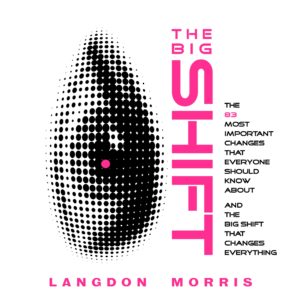
Happy New Year!
As we come to the end of 2019 and shift into the decade of the 2020s, we are naturally inspired to think ahead and to wonder what the future holds. This is true around every New Year’s holiday, but even more so this year since “2020” also has such a strong parallel meaning about the quality of our vision – can we see what’s ahead? What does the future hold for us?
Today’s global economy is built upon, and built for, rapid population growth. A growing population means increasing consumption, which is a reliable engine of growth for the world’s businesses. Population growth means new, young workers joining the work force, tax revenues for government, and new households being formed, with all the additional consumption that comes with it – more furniture, more TVs, more stuff. And while growth is considered an economic good, it’s a challenge for the environment, as more growth and more stuff means more consumption of resources and more waste, including of course more CO2.
Consequently, when we think about the future, it’s essential that we consider future population trends, as they will be decisively important to the future of society and the environment.
On a global basis, the birth rate is closely linked with urbanization, because where people live has a lot of impact on how many children they have.
It turns out that when families move from the countryside to the cities the birth rate drops, usually within a generation, so to understand the future of population growth it’s necessary to pay attention to the proportion of the world’s population that is rural, as compared with the proportion that’s urban.
In 1900, just ten percent of the world’s 1.5 billion people lived in cities, but from 1900 to 2000 the rapid spread of industrialization, sanitation, health care, and scientific knowledge led to the population explosion; the world population ballooned to 7 billion by 2000, creating fears of mass starvation and a population apocalypse.
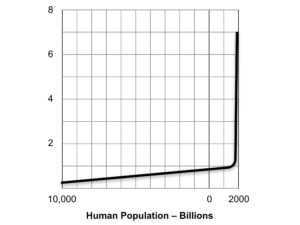
Until the 1980s, most of that population growth was in rural settings, but the pace of urbanization has accelerated since then, and the world’s population is becoming steadily more urbanized.
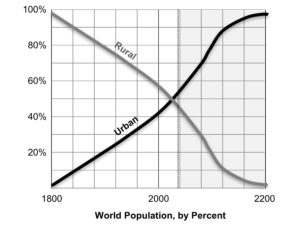
So if urbanization leads to a significant reduction in family size, then we ought to be seeing a decline in the overall global birth rate, and indeed we are. In fact, the decline is so fast that it’s quite possible that by 2050, a mere 30 years from now, the world’s population will peak.
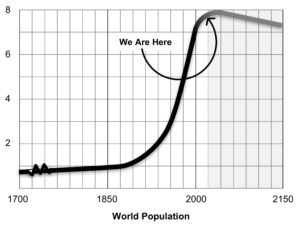
And what then?
At that point, and in fact long before, we will see a fundamental transformation of the global economy. This will not be a simple or easy transformation, but it will be a transformation nonetheless, because then the very structure of the economy will change, not because businesses or governments want it to change, but simply because the declining impetus of consumer demand will act as a brake on the economy.
In short, while the global economy is designed for, and requires, a booming population, the era of the population boom is quickly coming to an end. No one knows what the economy of 2050 will look like, but we can be sure it will not look like the economy of 2020.
Will this cause suffering? Surely it will.
Will this be a force that results in the rise of new companies and the fall of older ones? Surely it will.
And while urbanization and changing demographics drive a global economic transformation, an additional force will be fully at play, and it, too will have enormous impact. This is of course the arrival of yet another generation of new technologies, including robots, artificial intelligence, machine learning, virtual and augmented reality, and perhaps blockchains and quantum computing as well.
Each of these technologies promises to be an active driver of change, but perhaps frighteningly, they’re all maturing and arriving at once, and thus the tsunami of change that they portend could also be utterly transformative.
Whether this will be a positive transformation or a catastrophe depends a great deal on how we manage the transition.
Today we see already the early signs. The number one job globally, the form of work that more people do than any other, is driving vehicles. So what impact will self-driving cars, trucks, taxis, buses, and trams have on global employment? And already Amazon employs more than 100,000 robots in its warehouses, while more arrive each day. Soon there will be billions. Already artificial intelligence systems, i.e., computers, read and write legal documents, analyze x-rays, calculate logistics, and trade in the stock market.
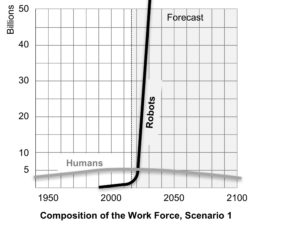
Work is therefore changing, just as the rate of population growth is changing, and while these may be seen as huge but separate forces, in fact they aren’t really separate at all, they’re two parts of one massive economic transformation that has already begun.
Adapting to these changes will require close attention to strategy, the process of thinking through how any organization will adapt to and create change, and to innovation, the internal driver of adaptation within organizations.
Already we are seeing the early impacts of these shifts, and those organizations that develop the necessary mindset and actions will gain enormous advantages as the process of change unfolds throughout this decade.
This, then is what the future holds: a time of great challenges and great opportunities as well!
The Roman Horace advised to carpe diem, to seize the day; we also think it’s time to carpe momentum, to seize the moment, a conveniently double meaning.
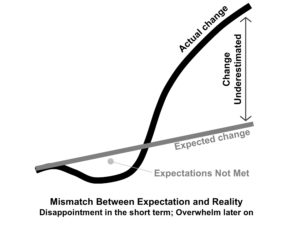
Or more simply, avoid the mismatch (see the graphic above) start getting ready now!
Change, strategy, and innovation are topics that we study and write about extensively, and we help our clients to understand these forces and to prepare for the impacts they will have. Please contact us if these are of interest to you, and we’ll be happy to discuss the strategic and innovation implications of accelerating change, and the actions you can take to get ready.
•••
InnovationLabs wishes everyone a wonderful year in 2020!
•••
The figures in this blog post appeared previously in our recent books Foresight and Extreme Creativity (2016) and The Big Shift (2018), where we explored these themes in great depth.



